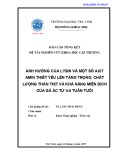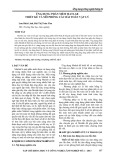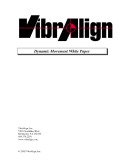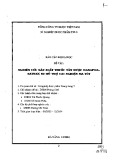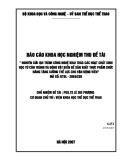
BEHAVIOR OF THE POSITIVE SOLUTIONS OF
FUZZY MAX-DIFFERENCE EQUATIONS
G. STEFANIDOU AND G. PAPASCHINOPOULOS
Received 15 September 2004
We extend some results obtained in 1998 and 1999 by studying the periodicity of the
solutions of the fuzzy difference equations xn+1 =max{A/xn,A/xn−1,...,A/xn−k},xn+1 =
max{A0/xn,A1/xn−1},wherekis a positive integer, A,Ai,i=0, 1, are positive fuzzy num-
bers, and the initial values xi,i=−k,−k+1,...,0 (resp., i=−1,0) of the first (resp., sec-
ond) equation are positive fuzzy numbers.
1. Introduction
Difference equations are often used in the study of linear and nonlinear physical, physio-
logical, and economical problems (for partial review see [3,6]). This fact leads to the fast
promotion of the theory of difference equations which someone can find, for instance,
in [1,7,9]. More precisely, max-difference equations have increasing interest since max
operators have applications in automatic control (see [2,11,17,18] and the references
cited therein).
Nowadays, a modern and promising approach for engineering, social, and environ-
mental problems with imprecise, uncertain input-output data arises, the fuzzy approach.
This is an expectable effect, since fuzzy logic can handle various types of vagueness but
particularly vagueness related to human linguistic and thinking (for partial review see
[8,12]).
The increasing interest in applications of these two scientific fields contributed to the
appearance of fuzzy difference equations (see [4,5,10,13,14,15,16]).
In [17], Szalkai studied the periodicity of the solutions of the ordinary difference equa-
tion
xn+1 =maxA
xn
,A
xn−1
,...,A
xn−k, (1.1)
where kis a positive integer, Ais a real constant, xi,i=−k,−k+1,..., 0 are real numbers.
More precisely, if Ais a positive real constant and xi,i=−k,−k+1,...,0 are positive real
numbers, he proved that every positive solution of (1.1) is eventually periodic of period
k+2.
Copyright ©2005 Hindawi Publishing Corporation
Advances in Difference Equations 2005:2 (2005) 153–172
DOI: 10.1155/ADE.2005.153

154 Fuzzy max-difference equations
In [2], Amleh et al. studied the periodicity of the solutions of the ordinary difference
equation
xn+1 =maxA0
xn
,A1
xn−1, (1.2)
where A0,A1are positive real constants and x−1,x0are real numbers. More precisely, if
A0,A1are positive constants, x−1,x0are positive real numbers, A0>A
1(resp., A0=A1)
(resp., A0<A
1), then every positive solution of (1.2) is eventually periodic of period two
(resp., three) (resp., four).
In this paper, our goal is to extend the above mentioned results for the corresponding
fuzzy difference equations (1.1)and(1.2)whereA,A0,A1are positive fuzzy numbers and
xi,i=−k,−k+1,...,0, x−1,x0are positive fuzzy numbers. Moreover, we find conditions
so that the corresponding fuzzy equations (1.1)and(1.2) have unbounded solutions,
something that does not happen in case of the ordinary difference equations (1.1)and
(1.2).
We note that, in order to study the behavior of a parametric fuzzy difference equation
we use the following technique: we investigate the behavior of the solutions of a related
family of systems of two parametric ordinary difference equations and then, using these
results and the fuzzy analog of some concepts known by the theory of ordinary difference
equations, we prove our main effects concerning the fuzzy difference equation.
2. Preliminaries
We need the following definitions.
For a set Bwe denote by ¯
Bthe closure of B. We say that a function Afrom R+=(0,∞)
into the interval [0,1] is a fuzzy number if Ais normal, convex fuzzy set (see [13]), upper
semicontinuous and the support suppA=a∈(0,1] [A]a={x:A(x)>0}is compact. Then
from [12, Theorems 3.1.5 and 3.1.8] the a-cuts of the fuzzy number A,[A]a={x∈R+:
A(x)≥a}are closed intervals.
We say that a fuzzy number Ais positive if suppA⊂(0,∞).
It is obvious that if Ais a positive real number, then Ais a positive fuzzy number and
[A]a=[A,A], a∈(0,1]. In this case, we say that Ais a trivial fuzzy number.
Let Bi,i=0,1,...,k,kis a positive integer, be fuzzy numbers such that
Bia=Bi,l,a,Bi,r,a,i=0,1,...,k,a∈(0,1], (2.1)
and for any a∈(0,1]
Cl,a=maxBi,l,a,i=0,1, ...,k,Cr,a=maxBi,r,a,i=0,1, ...,k.(2.2)
Then by [19, Theorem 2.1], (Cl,a,Cr,a) determines a fuzzy number Csuch that
[C]a=Cl,a,Cr,a,a∈(0,1].(2.3)
According to [8]and[14, Lemma 2.3] we can define
C=maxBi,i=0,1, ...,k.(2.4)

G. Stefanidou and G. Papaschinopoulos 155
We say that xnis a positive solution of (1.1)(resp.,(1.2)) if xnis a sequence of positive
fuzzy numbers which satisfies (1.1)(resp.,(1.2)).
We say that a sequence of positive fuzzy numbers xnpersists (resp., is bounded) if there
exists a positive number M(resp., N)suchthat
suppxn⊂[M,∞), resp., supp xn⊂(0,N],n=1,2,.... (2.5)
In addition, we say that xnis bounded and persists if there exist numbers M,N∈(0,∞)
such that
suppxn⊂[M,N], n=1,2,.... (2.6)
Asolutionxnof (1.1)(resp.,(1.2)) is said to be eventually periodic of period r,ris a
positive integer, if there exists a positive integer msuch that
xn+r=xn,n=m,m+1,.... (2.7)
3. Existence and uniqueness of the positive solutions
of fuzzy difference equations (1.1)and(1.2)
In this section, we study the existence and the uniqueness of the positive solutions of the
fuzzy difference equations (1.1)and(1.2).
Proposition 3.1. Suppose that A,A0,A1are positive fuzzy numbers. Then for all positive
fuzzy numbers x−k,x−k+1,...,x0(resp., x−1,x0) there exists a unique positive solution xnof
(1.1) (resp., (1.2)) with initial values x−k,x−k+1,...,x0(resp., x−1,x0).
Proof. Suppose that
[A]a=Al,a,Ar,a,a∈(0,1].(3.1)
Let xi,i=−k,−k+1,...,0 be positive fuzzy numbers such that
xia=Li,a,Ri,a,i=−k,−k+1,...,0, a∈(0,1] (3.2)
and let (Ln,a,Rn,a), n=0,1,...,a∈(0,1], be the unique positive solution of the system of
difference equations
Ln+1,a=maxAl,a
Rn,a
,Al,a
Rn−1,a
,...,Al,a
Rn−k,a,
Rn+1,a=maxAr,a
Ln,a
,Ar,a
Ln−1,a
,...,Ar,a
Ln−k,a(3.3)
with initial values (Li,a,Ri,a), i=−k,−k+1,...,0. Using [19, Theorem 2.1] and relation
(3.3)andworkingasin[13, Proposition 2.1] and [15, Proposition 1] we can easily prove
that (Ln,a,Rn,a), n=1,2,...,a∈(0,1] determines a sequence of positive fuzzy numbers
xnsuch that
xna=Ln,a,Rn,a,n=1,2,...,a∈(0,1].(3.4)

156 Fuzzy max-difference equations
Now, we prove that xnsatisfies (1.1) with initial values xi,i=−k,−k+1,...,0.From(3.1),
(3.2), (3.3), (3.4), [15, Lemma 1], and by a slight generalization of [14, Lemma 2.3] we
have
maxA
xn
,A
xn−1
,...,A
xn−ka
=maxAl,a
Rn,a
,Al,a
Rn−1,a
,...,Al,a
Rn−k,a,maxAr,a
Ln,a
,Ar,a
Ln−1,a
,...,Ar,a
Ln−k,a
=Ln+1,a,Rn+1,a=xn+1a,a∈(0, 1].
(3.5)
From (3.5)andarguingasin[13, Proposition 2.1] and [15, Proposition 1] we have that
xnis the unique positive solution of (1.1)withinitialvaluesxi,i=−k,−k+1,...,0.
Now, suppose that
Aia=Ai,l,a,Ai,r,a,i=0,1, a∈(0,1].(3.6)
Arguing as above and using (3.6) we can easily prove that if xi,i=−1,0 are positive fuzzy
numbers which satisfy (3.2)fork=1, then there exists a unique positive solution xn
of (1.2) with initial values xi,i=−1, 0 such that (3.4)holdsand(Ln,a,Rn,a) satisfies the
system of difference equations
Ln+1,a=maxA0,l,a
Rn,a
,A1,l,a
Rn−1,a,Rn+1,a=maxA0,r,a
Ln,a
,A1,r,a
Ln−1,a.(3.7)
This completes the proof of the proposition.
4. Behavior of the positive solutions of fuzzy equation (1.1)
In this section, we study the behavior of the positive solutions of (1.1). Firstly, we study
the periodicity of the positive solutions of (1.1). We need the following lemmas.
Lemma 4.1. Let A,a,bbe positive numbers such that ab = A.If
ab < A (resp.,ab > A), (4.1)
then there exist positive numbers ¯
y,¯
zsuch that
¯
y¯
z=A, (4.2)
a< ¯
y,b<¯
zresp.,a> ¯
y,b>¯
z.(4.3)
Proof. Suppose that (4.1) is satisfied. Then if ǫis a positive number such that
ǫ<A−ab
bresp.,ǫ<ab −A
b,
¯
y=a+ǫ,¯
z=A
a+ǫresp.,¯
y=a−ǫ,¯
z=A
a−ǫ,
(4.4)
it is obvious that (4.2)and(4.3) hold. This completes the proof of the lemma.

G. Stefanidou and G. Papaschinopoulos 157
Lemma 4.2. Consider the system of difference equations
yn+1 =maxA
zn
,A
zn−1
,...,A
zn−k,zn+1 =maxA
yn
,A
yn−1
,...,A
yn−k, (4.5)
where Ais a positive real constant, kis a positive integer, and yi,zi,i=−k,−k+1,...,0 are
positive real numbers. Then every positive solution (yn,zn)of (4.5)iseventuallyperiodicof
period k+2.
Proof. Let (yn,zn) be an arbitrary positive solution of (4.5). Firstly, suppose that there
exists a λ∈{1, 2,...,k+2}such that
yλzλ<A. (4.6)
Then from (4.6)andLemma 4.1 there exist positive constants ¯
y,¯
zsuch that (4.2)holds
and
yλ<¯
y,zλ<¯
z. (4.7)
From (4.2), (4.5), and (4.7)wehave,fori=λ+1,λ+2,...,k+λ+1,
yi=maxA
zi−1
,A
zi−2
,...,A
zi−k−1≥A
zλ
>A
¯
z=¯
y,zi>¯
z. (4.8)
Then relations (4.2), (4.5), and (4.8)implythat
yk+λ+2 =maxA
zk+λ+1
,A
zk+λ
,...,A
zλ+1 <A
¯
z=¯
y,zk+λ+2 <¯
z. (4.9)
Therefore, from (4.2), (4.5), (4.8), and (4.9)wetake,for j=k+λ+3,k+λ+4,...,2k+
λ+3,
yj=maxA
zj−1
,A
zj−2
,...,A
zj−k−1=A
zk+λ+2
,zj=A
yk+λ+2
.(4.10)
So, from (4.5), (4.9), (4.10) and working inductively for i=0,1,... and j=3,4,...,k+3
we can easily prove that
yk+λ+2+i(k+2) =yk+λ+2,yk+λ+j+i(k+2) =A
zk+λ+2
,
zk+λ+2+i(k+2) =zk+λ+2,zk+λ+j+i(k+2) =A
yk+λ+2
(4.11)
and so it is obvious that (yn,zn)iseventuallyperiodicofperiodk+2.
Therefore, if relation
yk+2zk+2 <A (4.12)
holds, then (yn,zn) is eventually periodic of period k+2.

